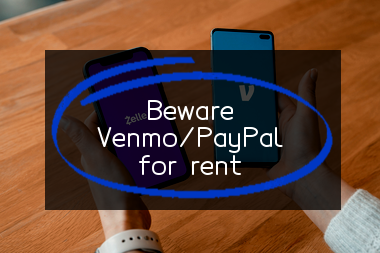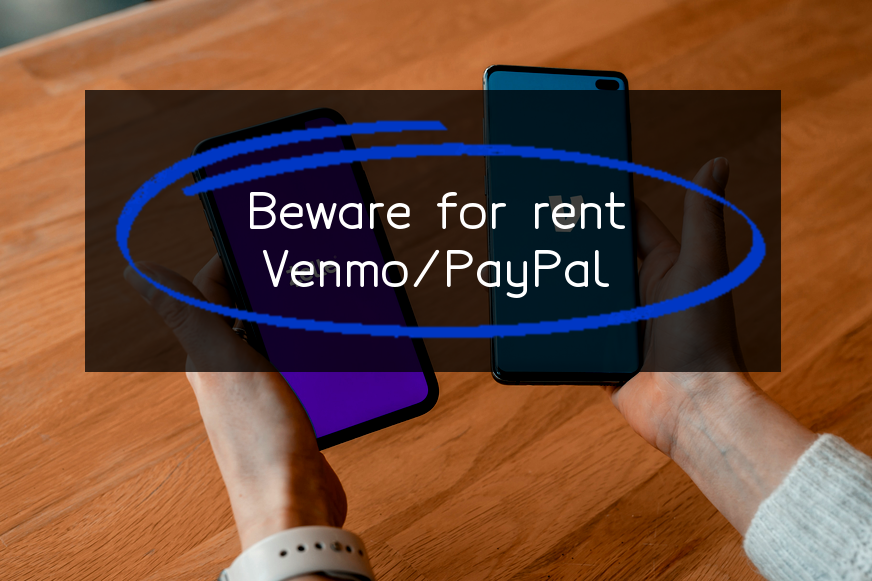There are several reasons why landlords should never use Venmo or Paypal to collect rent:
- 1. Fees: Both Venmo and Paypal charge transaction fees for each transfer, which can add up quickly if a landlord is collecting rent from multiple tenants. These fees can eat into a landlord's profits and increase the cost of doing business.
- 2. Security: Venmo and Paypal are not designed for business use and do not offer the same level of security and protection as dedicated payment processors. There is also a risk of fraud and scams when using these services for rent payments.
- 3. Lack of accountability: Venmo and Paypal do not provide a paper trail or receipt of payment that is necessary for legal purposes. This can put a landlord at risk of potential disputes and litigation in the event of a payment dispute.
- 4. Payment timing: Venmo and Paypal transfers can take several business days to process, which can disrupt a landlord's cash flow and make it difficult to pay bills and expenses on time.
Overall, it is best for landlords to use a dedicated rent payment processor or accept traditional methods of payment like checks or money orders. These options provide greater security, accountability, and cost savings for landlords.
Using Venmo to collect rent
Venmo is a popular mobile payment service that allows users to transfer money to one another using a mobile app. Venmo can be a convenient way to collect rent because it is fast, secure, and easy to use.
To use Venmo to collect rent, follow these steps:
- 1Download the Venmo app on your mobile device and create an account.
- 2Link your Venmo account to your bank account or debit card.
- 3Add your tenants as friends on Venmo.
- 4Request payment from your tenants by selecting the "Request" feature on the Venmo app.
- 5Enter the amount of rent owed and select the tenants you want to request payment from.
- 6Once your tenant receives the request, they can pay it immediately using their Venmo balance or by linking their bank account or debit card.
- 7Once your tenant has paid the rent, the money will be automatically transferred to your Venmo account.
- 8You can transfer the money from your Venmo account to your bank account for free or keep it in your Venmo balance to use for other payments.
Using Venmo to collect rent can save time and reduce the need for physical checks, making it a convenient option for both landlords and tenants. Additionally, Venmo provides a record of all transactions, making it easier to keep track of rent payments and avoid disputes.
Using PayPal to collect rent
Generally, using PayPal to collect rent involves the following steps:
- 1Setting up a PayPal account: Before using PayPal to collect rent, the landlord must first create a PayPal account.
- 2Requesting tenant's email address: The landlord then requests the tenant's email address, which is linked to their PayPal account.
- 3Sending a payment request: After obtaining the tenant's email address, the landlord can now send a payment request to the tenant for the rent amount owed. The payment request can be sent through PayPal's "Request Money" feature.
- 4Tenant payment: Once the tenant receives the payment request, they can log in to their PayPal account and make the rent payment.
- 5Landlord confirming payment: After the tenant has made the payment, the landlord will receive a notification from PayPal confirming the payment.
- 6Payment availability: The landlord can then decide whether to transfer available funds to their linked bank account or keep the funds in their PayPal account.
Using PayPal to collect rent offers a secure, convenient, and fast way for landlords to receive rent payments from tenants. PayPal also provides a record of all transactions made, making it easier for landlords to manage their finances.
Why use property management apps?
Landlords should use property management apps for several reasons:
- 1Improved Organization: With a property management app, landlords can easily organize their tenant information, lease agreements, rent payments, maintenance requests and more in one place. This reduces the risk of missed or lost information.
- 2Efficient Communication: Property management apps provide landlords with the tools to communicate efficiently and quickly with tenants, maintenance staff, and other service providers. Messages can be sent via the app, text, or email, ensuring important information reaches the intended recipient.
- 3Easy Rent Collection: Property management apps allow landlords to collect rent electronically, eliminating the need for tenants to write checks or hand over cash. This ensures reliable and timely payments.
- 4Simplify Maintenance: Property management apps simplify maintenance requests by providing tenants with an easy way to report any issues or concerns. These requests can be documented, prioritized, and tracked until they are resolved.
- 5Better Tenant Management: Property management apps enable landlords to keep a closer eye on tenant behavior, including rent payment history and past maintenance requests. This information can be used to make informed decisions about leases, renewals, and screening new tenants.
Overall, property management apps help landlords streamline their business processes, boost efficiency, reduce errors, and save time. They also improve tenant satisfaction, which is essential for maintaining a positive landlord-tenant relationship.
Closing Thoughts
I can provide a general statement about rent collection. Rent collection is an essential part of managing rental properties. It ensures that property owners receive a steady income from their investments while also providing tenants with a safe place to live. Effective rent collection involves establishing clear policies and procedures, communicating them clearly to tenants, and following up consistently when payments are late or overdue. Landlords should maintain a professional relationship with tenants while also enforcing their rental agreements to maintain a sustainable working relationship.
Just one more thing: if you liked the article, please like us on social media and share this article with friends.



